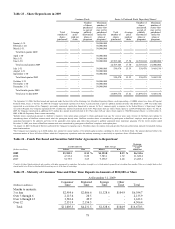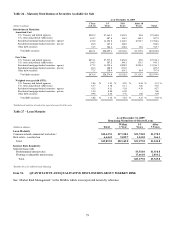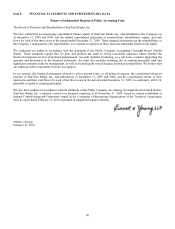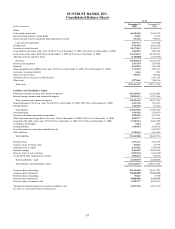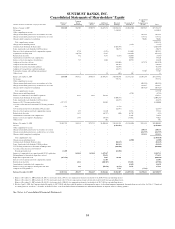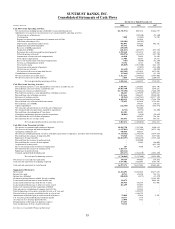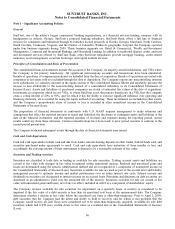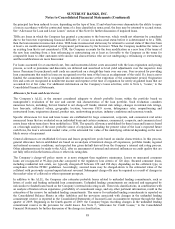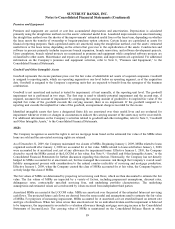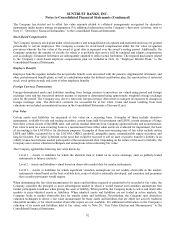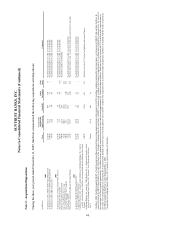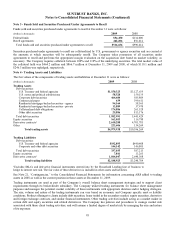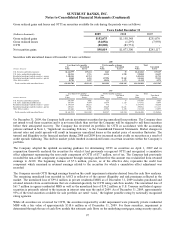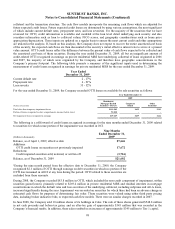SunTrust 2009 Annual Report Download - page 104
Download and view the complete annual report
Please find page 104 of the 2009 SunTrust annual report below. You can navigate through the pages in the report by either clicking on the pages listed below, or by using the keyword search tool below to find specific information within the annual report.SUNTRUST BANKS, INC.
Notes to Consolidated Financial Statements (Continued)
the principal has been reduced to zero, depending on the type of loan. If and when borrowers demonstrate the ability to repay
a loan in accordance with the contractual terms of a loan classified as nonaccrual, the loan may be returned to accrual status.
See “Allowance for Loan and Lease Losses” section of this Note for further discussion of impaired loans.
TDRs are loans in which the Company has granted a concession to the borrower, which would not otherwise be considered
due to the borrower experiencing financial difficulty. If a loan is in nonaccrual status before it is determined to be a TDR,
then the loan remains in nonaccrual status. TDR loans in nonaccrual status may be returned to accrual status if there has been
at least a six month sustained period of repayment performance by the borrower. When the Company modifies the terms of
an existing loan that is not considered a TDR, the Company accounts for the loan modification as a new loan if the terms of
the new loan resulting from a loan refinancing or restructuring are at least as favorable to the Company as the terms for
comparable loans to other customers with similar risk characteristics who are not undergoing a refinancing or restructuring
and the modifications are more than minor.
For loans accounted for at amortized cost, fees and incremental direct costs associated with the loan origination and pricing
process, as well as premiums and discounts, are deferred and amortized as level yield adjustments over the respective loan
terms. Premiums for purchased credit cards are amortized on a straight-line basis over one year. Fees received for providing
loan commitments that result in loans are recognized over the term of the loan as an adjustment of the yield. If a loan is never
funded, the commitment fee is recognized into noninterest income at the expiration of the commitment period. Origination
fees and costs are recognized in noninterest income and expense at the time of origination for newly originated loans that are
accounted for at fair value. For additional information on the Company’s loans activities, refer to Note 6, “Loans,” to the
Consolidated Financial Statements.
Allowance for Loan and Lease Losses
The Company’s ALLL is the amount considered adequate to absorb probable losses within the portfolio based on
management’s evaluation of the size and current risk characteristics of the loan portfolio. Such evaluation considers
numerous factors, including, but not limited to net charge-off trends, internal risk ratings, changes in internal risk ratings,
loss forecasts, collateral values, geographic location, borrower FICO scores, delinquency rates, nonperforming and
restructured loans, origination channel, product mix, underwriting practices, industry conditions and economic trends.
Specific allowances for loan and lease losses are established for large commercial, corporate, and commercial real estate
nonaccrual loans that are evaluated on an individual basis and certain consumer, commercial, corporate, and commercial real
estate loans whose terms have been modified in a TDR. The specific allowance established for these loans and leases is based
on a thorough analysis of the most probable source of repayment, including the present value of the loan’s expected future
cash flows, the loan’s estimated market value, or the estimated fair value of the underlying collateral depending on the most
likely source of repayment.
General allowances are established for loans and leases grouped into pools based on similar characteristics. In this process,
general allowance factors established are based on an analysis of historical charge-off experience, portfolio trends, regional
and national economic conditions, and expected loss given default derived from the Company’s internal risk rating process.
Other adjustments may be made to the ALLL after an assessment of internal and external influences on credit quality that are
not fully reflected in the historical loss or other risk rating data.
The Company’s charge-off policy meets or is more stringent than regulatory minimums. Losses on unsecured consumer
loans are recognized at 90-days past-due compared to the regulatory loss criteria of 120 days. Secured consumer loans,
including residential real estate, are typically charged-off between 120 and 180 days, depending on the collateral type, in
compliance with the FFIEC guidelines. Accordingly, secured loans may be charged-down to the estimated value of the
collateral with previously accrued unpaid interest reversed. Subsequent charge-offs may be required as a result of changes in
the market value of collateral or other repayment prospects.
In addition to the ALLL, the Company also estimates probable losses related to unfunded lending commitments, such as
letters of credit and binding unfunded loan commitments. Unfunded lending commitments are analyzed and segregated by
risk similar to funded loans based on the Company’s internal risk rating scale. These risk classifications, in combination with
an analysis of historical loss experience, probability of commitment usage, and any other pertinent information, result in the
estimation of the reserve for unfunded lending commitments. The reserve for unfunded lending commitments is reported on
the Consolidated Balance Sheets in other liabilities and the provision associated with changes in the unfunded lending
commitment reserve is reported in the Consolidated Statements of Income/(Loss) in noninterest expense through the third
quarter of 2009. Beginning in the fourth quarter of 2009, the Company began recording changes in the unfunded lending
commitment reserve in the provision for credit losses. See Note 7, “Allowance for Credit Losses,” to the Consolidated
Financial Statements for further discussion of the change in classification.
88


